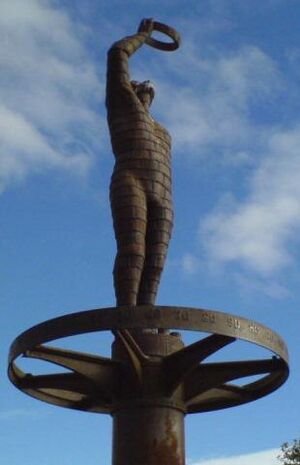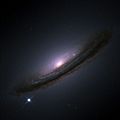Cosmic distance ladder facts for kids

The cosmic distance ladder helps astronomers figure out how far away objects in space are. Think of it like a ladder with many steps. Each step uses a different method to measure distances. Some methods work for nearby objects, while others work for things much farther away.
Astronomers can only measure distances directly for objects that are relatively close to Earth. These are usually within about a thousand parsecs (a parsec is a unit of distance used in astronomy). For objects that are super far away, scientists use clever tricks. They connect methods that work for close objects to methods that work for distant ones.
Many of these methods rely on something called a standard candle. This is a special type of astronomical object that has a known brightness. If you know how bright something truly is, and you can see how bright it appears from Earth, you can figure out its distance.
The "ladder" idea comes from the fact that no single method can measure all distances in space. Instead, one method helps measure nearby distances. Then, that information helps with the next method, which measures slightly farther distances, and so on. Each "rung" or step of the ladder builds on the one before it.
Measuring Distances in Space
At the very bottom of this cosmic ladder are the most basic ways to measure distance. These methods figure out distances directly, without making guesses about the object itself. This careful measurement of star positions is part of a science called astrometry.
One of the most important direct measurements is the distance between Earth and the Sun. This distance is called the Astronomical Unit (AU). In the past, astronomers used to watch Venus pass in front of the Sun to help figure out the AU. Later, they used observations of asteroids.
Today, we can measure the AU very precisely using radar. We send radar signals to Venus and other nearby planets or asteroids. By timing how long it takes for the signal to bounce back, we can calculate the distance. We also track spacecraft as they orbit the Sun in our Solar System.
Kepler's Laws of planetary motion tell us the exact ratios of the sizes of orbits around the Sun. But they don't tell us the actual size in kilometers. Radar measurements help us find the real distances in kilometers, filling in those missing numbers.
Images for kids
-
The Astronomer shows the use of parallax to measure distance. It is made from parts of the Yale–Columbia Refractor telescope (1924) damaged when the 2003 Canberra bushfires burned out the Mount Stromlo Observatory; at Questacon, Canberra.
-
Parallax measurements may be an important clue to understanding three of the universe's most elusive components: dark matter, dark energy and neutrinos.
-
Hubble precision stellar distance measurement has been extended 10 times further into the Milky Way.
See also
 In Spanish: Escalera de distancias cósmicas para niños
In Spanish: Escalera de distancias cósmicas para niños







